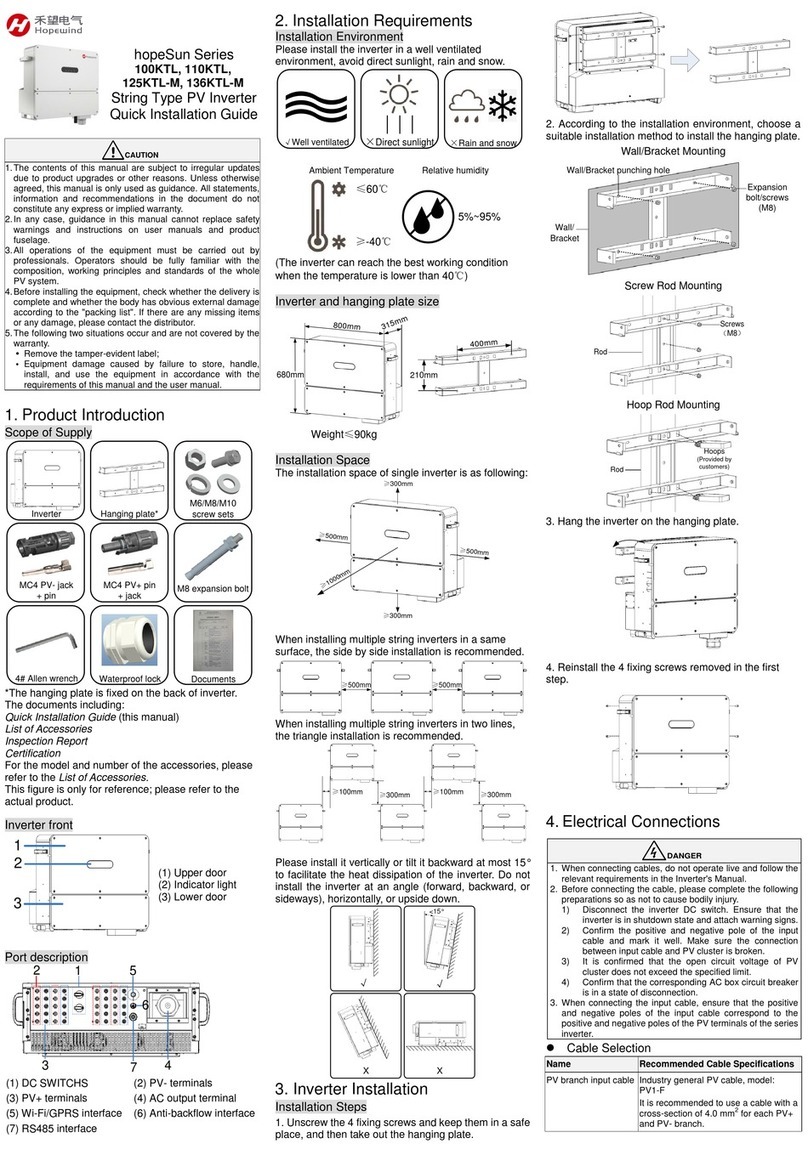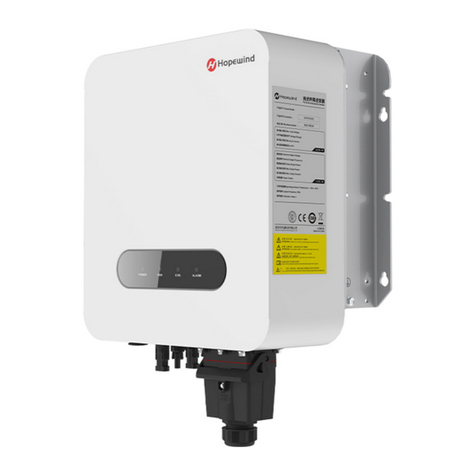
Cable Selection
Recommended Cable Specifications
Industry general PV cable, model: PV1-F
It is recommended to use a cable with a
cross-section of 4.0 mm2 for each PV+ and PV-
branch.
4 core outdoor cable (A, B, C, N) or 3 core
outdoor cable (A, B, C)
Recommended cross sectional area of
conductor (copper):35mm2
RS485
communication
cable
It is recommended to use a special
communication cable or 4-core or 2-core
shielded twisted pair cable with a
cross-sectional area of not less than 0.75mm2.
It is recommended to use at least one grounded
dedicated cable with a cross-sectional area of
16 mm2.
Note:
1. The AC output has only 1 waterproof locks with a specification
of 42mm~50mm. When the screw is locked, use the sleeve to
calibration.
2. The RS485 communication cable has only one waterproof
lock and the size is 18mm~25mm.
Output side cable connection
1. Crimping the OT terminal. Users need to prepare
the OT terminals themselves. The OT terminal
model of PE is M6, and the model of AC is M8.
1) Strip the front end of the cable core.
OT terminal
Cable LL+(2~3)mm
2) Put on the heat shrink tubing and OT terminal.
3) Crimp the OT terminal.
4) Move the heat shrink tubing forward to cover
the seam.
5) Use a dryer to heat the sleeve to make it tight.
2. Ground connection:
Note: The ground cable must be reliably connected to the
grounding bar.
3. DC output cable connection:
1) Remove the lower door by 4# Allen wrench.
2) Tear off the AC output protective film and
install the waterproof lock.
Put in the
waterproof
lock parts
and screw
them
together
3) Screw off the locking cap of the AC output
waterproof lock.
4) The AC cables are connected to A, B, C and
N of theAC terminal row in turn, and the
fastening torque is 8N*m. Fasten the locking
cap after completion.
PV Input Cable Connection
1. Crimp the MC4 terminal:
1) Confirm the positive and negative terminals of
the input cable and mark them.
Note: Please do not judge by the color of the cable
only, be sure to refer to the actual measurement.
2) Stripping with a wire stripper;
Stripping length
requirement
positive
negative
3) Press the cable together with the
corresponding core according to the correct
polarity.
Crimp
method
Positive
Negative
4) Insert the core into the male and female ends
of the MC4 connector and tighten the
connector back cover according to the correct
polarity.
2. Remove the sealing plugs of the input terminals at
the bottom of the inverter. Connect the positive
and negative terminals of each input cable to the
PV+ and PV- input terminals of the inverter one by
one. Insert it until you hear a "click".
3. If there are unconnected input terminals, please
confirm that the unconnected input terminals
remain sealed by the plugs.
RS485 Communication Cable Connection
On the RS485 adapter board X3, two RS485 interfaces
(labeled P2, P3) are shown. This interface is used to
connect adjacent inverters.
1. Crimp the 485 terminal. Users need to prepare the
terminals themselves, and the terminals model
needs to match the 485 cable selected.
1) Strip the front end of the cable core.
2) Insert the terminal and crimp.
2. Unscrew the RS485 waterproof lock and take off
the seal baffle.
3. Pass the RS485 cable through the waterproof lock
and connect it to the interface P2, P3 on the
RS485 adapter board X3. Tighten the locking cap
after completion.
P2
P3
P1
3PIN: 485-
2PIN: PE
1PIN: 485+
4. Reinstall the lower door panel of the inverter.
The connection of multiple inverters is suggested to be
connected in series in the following diagram.
1# inverter
X3
2# inverter 3# inverter
N# inverter
Data collector
Follow
this
mode
in
series
P3
P2 X3
P3
P2 X3
P3
P2
X3
P3
P2
485 interface
485 interface
5.Post-installation Check
1. Confirm that the inverter is securely installed in place
2. Check if the ground wire is properly connected,
whether the connection is reliable and secure, and
ensure that there is no open-circuit or short-circuit
3. Check that the output cable is properly connected, that
the connection is reliable and secure, and that there is no
open-circuit or short-circuit.
4. Check whether the DC input cable connection polarity
is correct, whether the connection is reliable and secure,
and ensure that there is no open-circuit or short-circuit.
5. Check if the RS485 communication cable connection is
correct and reliable.
6. Check if the inverter's lower door panel is replaced and
the door panel screws are tightened.
7. Check if the DC input terminals that are not needed are
sealed
6.LED indicators Description
Both PV side and grid side
are normal
Grid side is normal, PV side
is abnormal
PV side is normal, grid side is
not connected
Both PV side and grid side
are not connected
Inverter is not in operation
Communication is abnormal
Note:
Slow flash: 1 sec on, 2 sec off;
Flash: 0.5 sec on, 0.5 sec off.
©Copyright Shenzhen Hopewind Electric Co., Ltd.
Address: Building No.11, 2nd Industrial Park of Guanlong Village,
Nanshan District, Shenzhen, China
Tel:0755-8602 6786























